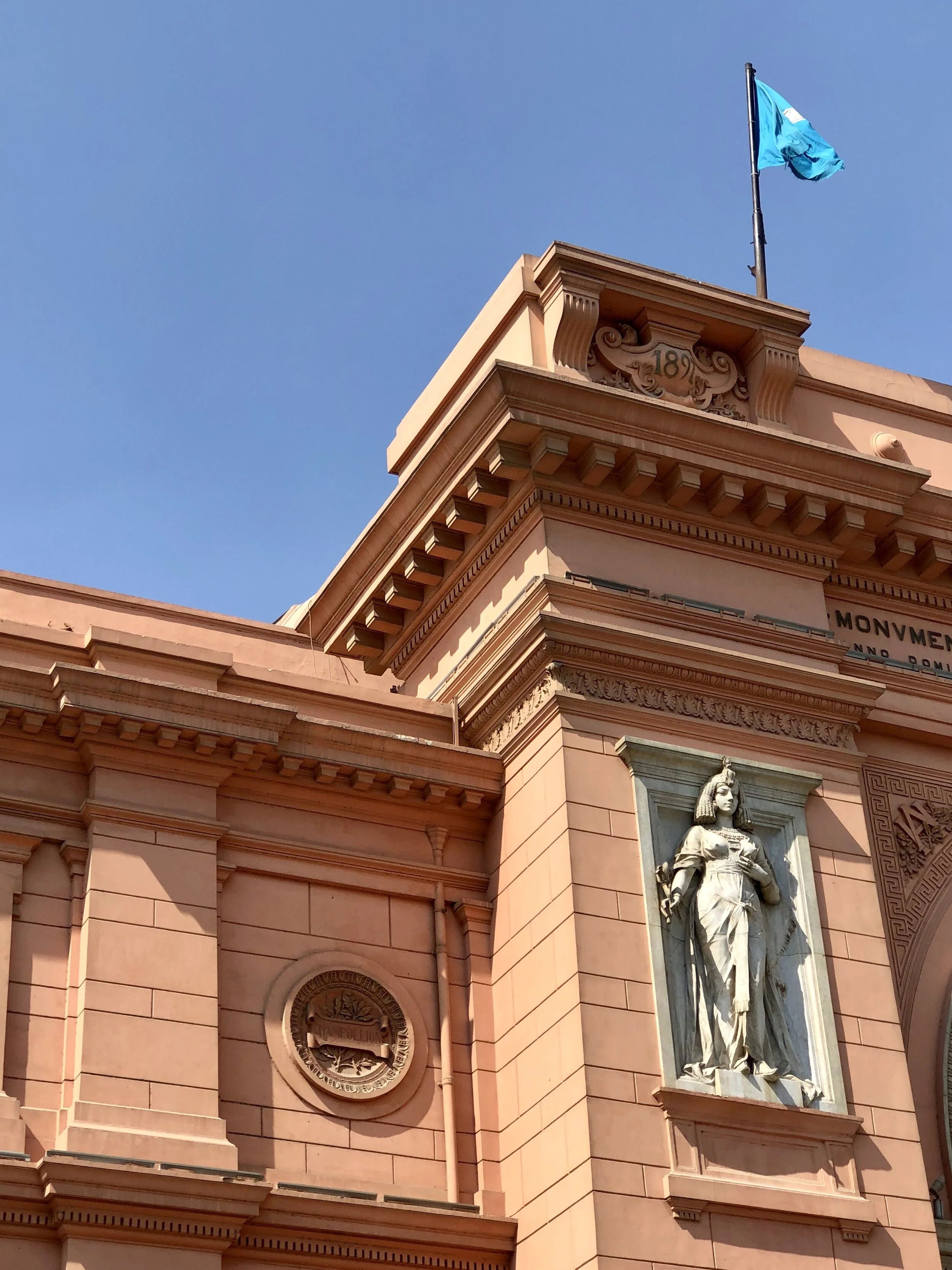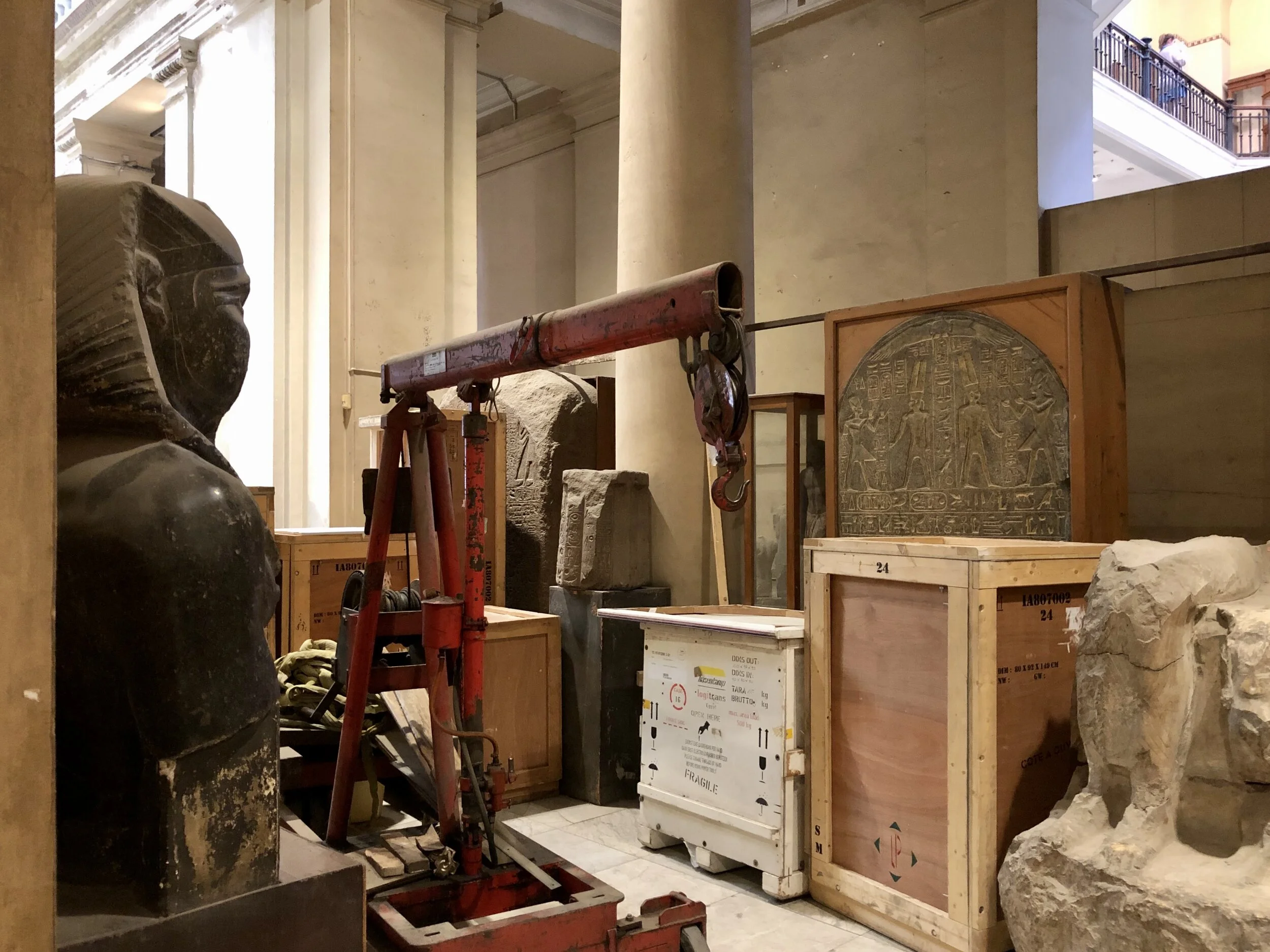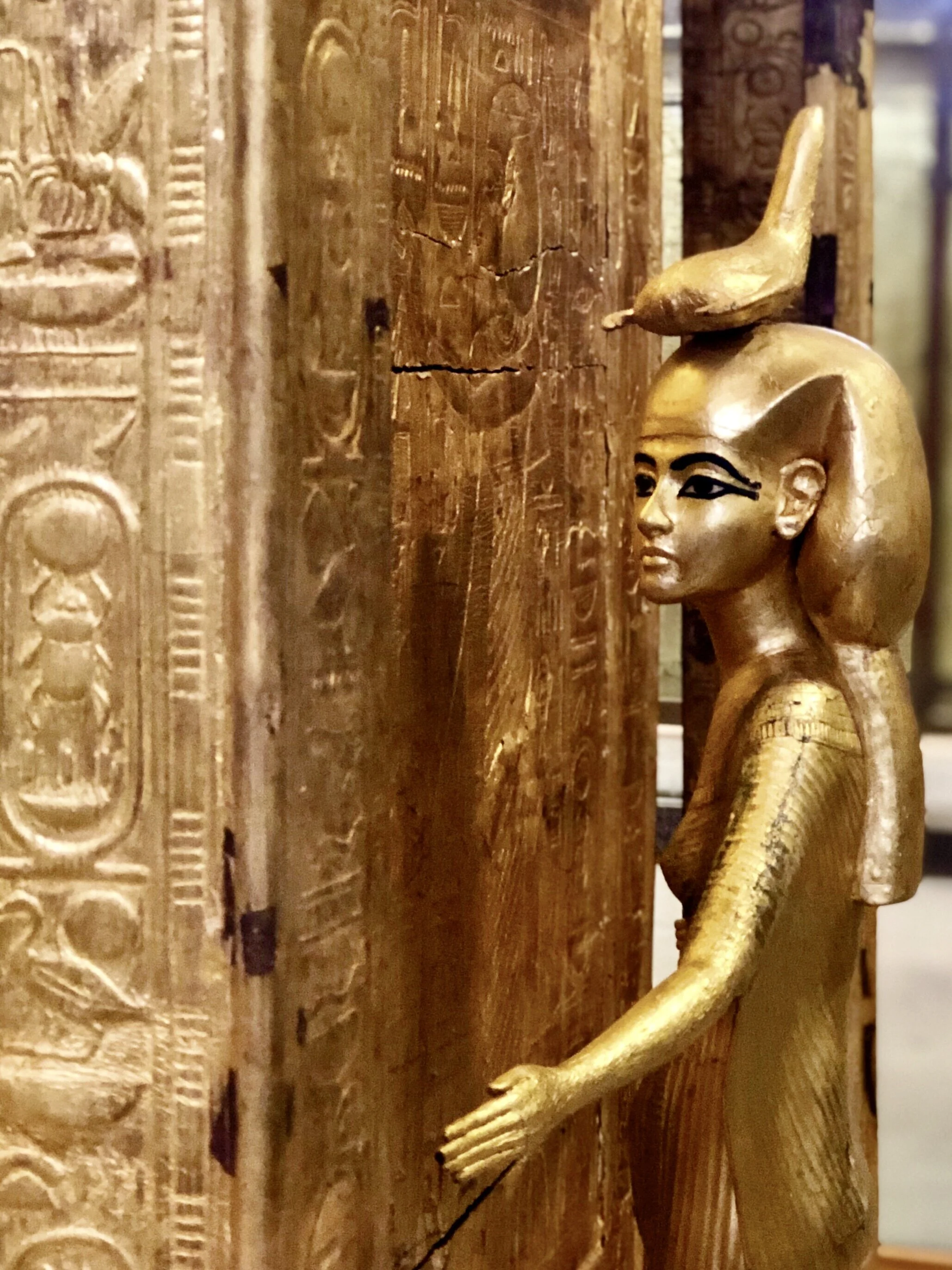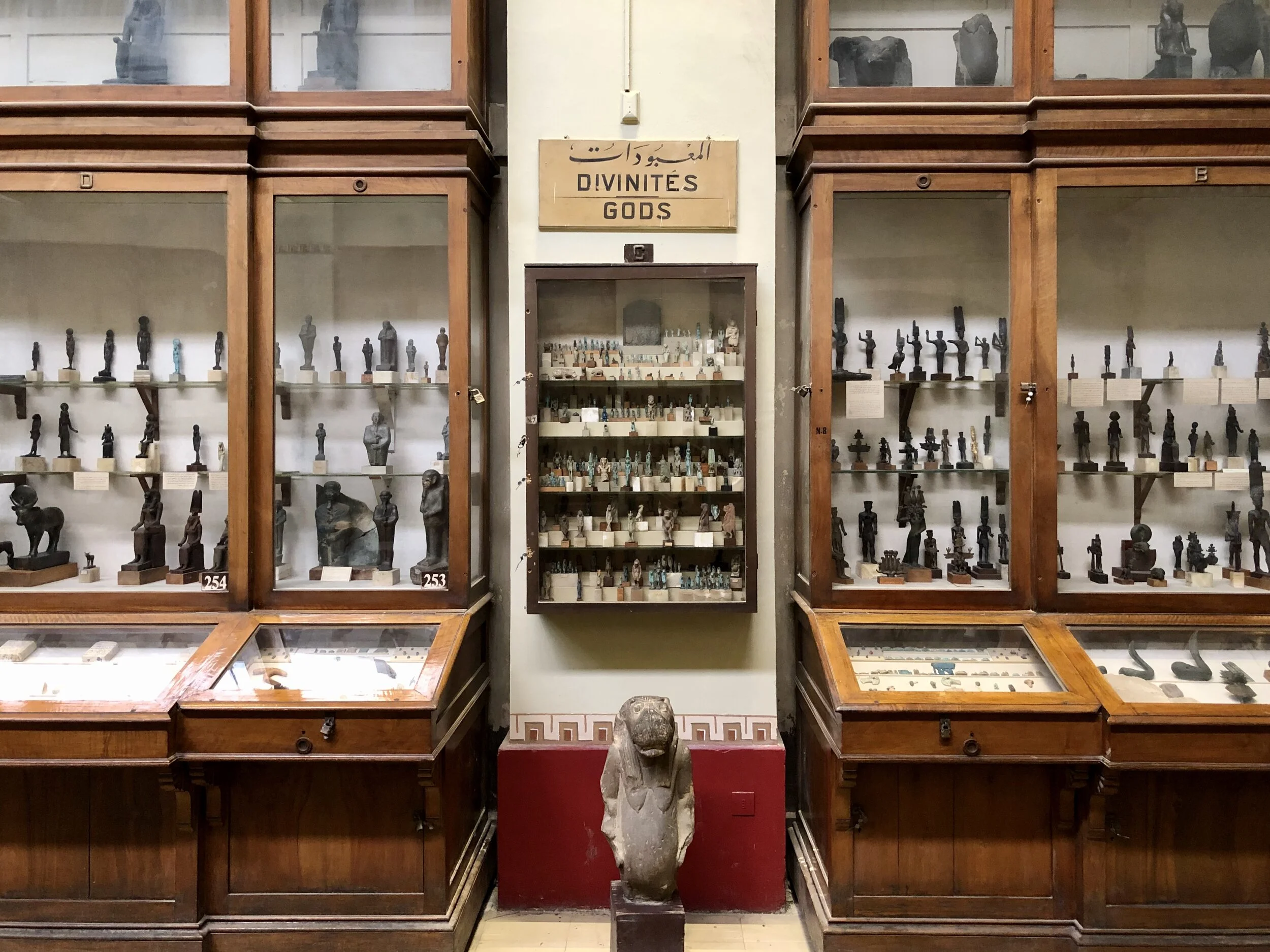The decidedly old-school Museum of Egyptian Antiquities houses impressive collections from Ancient Egypt, including the mummies of numerous pharaohs, Amarna Period relics and the treasures of King Tut’s tomb (for now).
Be sure to explore the peaceful park in front of the salmon-colored museum, which opened in this spot in 1902
There was simply no way I was going to miss the treasures of Tutankhamun, much less the mummies of the pharaohs. So I knew our trip to Cairo wouldn’t be complete without a visit to the landmark Egyptian Museum.
It was a dry, hot morning when Wally and I left the Kempinski Nile Hotel and walked along the Corniche — the grand boulevard that runs parallel to the Nile River. The thoroughfare was not yet car-choked, and we had to walk past armed military police as we approached the Museum of Egyptian Antiquities, more commonly known as the Egyptian Museum.
“The Egyptian Museum felt trapped in time, a bit like the decaying mansion of Miss Havisham, the jilted spinster from Charles Dickens’ novel “Great Expectations.””
The colossi of Pharaoh Amenhotep III and Queen Tiye tower above Wally (a queen shown actual size)
The Egyptian Museum’s Rough Start
The museum’s first home was established in 1863 by French Egyptologist Auguste Mariette on the banks of the Nile, in Cairo’s Bulaq district. Over time, its extensive collection continued to grow, but in 1878, one of the worst floods in Egypt’s history completely destroyed much of the building, as well as some of Mariette’s drawings and excavation documents. The artifacts were temporarily relocated to the royal palace of Ismail Pasha at Giza after the catastrophe.
Construction on a new museum began in 1897 at its present location in Tahrir Square, an address that’s now known as the site of protests during the Egyptian Revolution of 2011, part of the Arab Spring. It officially opened its doors to the public on November 15, 1902.
A pair of larger-than-life figures personifying the goddesses of Upper and Lower Egypt adorn the museum’s façade on either side of the entry arch
The main façade of the salmon-colored Beaux-Arts style structure features a pair of Art Nouveau female figures personifying the goddesses of Upper and Lower Egypt. The museum’s collection consists of approximately 120,000 objects — the largest assemblage of pharaonic antiquities dating from the Old Kingdom (circa 2613-2181 BCE) to the Greco-Roman Period (332 BCE-395 CE).
We purchased our tickets, which included general admission and the two rooms of royal mummies for 300 Egyptian pounds (just under 20 bucks when we visited), plus an additional ticket for photography for 50 L.E. (about $3).
Looking down upon the entrance, with its metal detectors
Exploring the Egyptian Museum
We made our way through the courtyard, which contains a reflecting pool with papyrus, additional stone artifacts and a monument dedicated to Mariette. Passing through the museum’s arched entrance, we paused at a security checkpoint, where we showed our tickets and placed our phones in plastic bins before entering. Make sure to look up at the sculpted keystone of the central arch with its Art Nouveau depiction of the goddess Isis, wearing the headdress of Hathor: a solar disc cradled between the horns of a cow.
Peek behind a wall partition and you’ll see just how disorganized the Egyptian Museum is
Lose Yourself in the Cluttered Collections
The museum has two floors, each of which is arranged in roughly chronological order. Objects are displayed amongst wooden crates and errant forklifts, giving the space a transitory feel. The sprawling second floor halls are filled row upon row of glass cases haphazardly combined with cabinets of curiosities. The Egyptian Museum felt trapped in time, a bit like the decaying mansion of Miss Havisham, the jilted spinster from Charles Dickens’ novel Great Expectations.
The section on the Amarna Period, with Akenhaten’s defaced sarcophagus in the foreground
The Good: The Androgynous Amarna Period
One of our favorite parts of the museum was the section on the Amarna Period. At the center of this collection are Akhenaten and his wife Nefertiti. Akhenaten is remembered as the “Heretic King” who abandoned traditional Egyptian polytheism in favor of the monotheistic worship of a single god, the Aten. His reign and art are referred to as Amarna because of the Beni Amran, a Bedouin tribe living in the area when his short-lived capital city was discovered by archaeologists.
The royal family shown worshipping the Aten (aka the sun) and its life-giving rays — check out those thunder thighs!
The Aten was depicted as the disc of the sun, whose rays ended in hands reaching out to touch the royal family. What we like best about the Amarna style is its sculpture, which differs radically from the rest of Ancient Egyptian art, which remained largely static for millennia. Perhaps the androgynous elongation and curved form of the colossal statues of Akhenaten and Nefertiti were meant to illustrate the transformative power of the Aten’s rays?
The unfinished yet still stunning bust of Nefertiti
Don’t miss the unfinished quartzite head of Nefertiti with the sculptor’s ink marks still intact, and take a moment to gaze upon the coffin of Akhenaten, which was defaced after his death. His cartouche (the hieroglyphic symbol with a pharaoh’s name) on the lid of the coffin was obliterated so that his spirit would be unable to return in the afterlife.
Catch the treasures of King Tut before they’re moved to the new Grand Egyptian Museum
King Tut…at Last!
The incredible Tutankhamun galleries are located on the second floor — a collection I have wanted to see ever since I was a little boy. It contains hundreds of funerary objects from Tutankhamun’s tomb, including the black jackal-topped Anubis shrine and gilded canopic shrine surrounded by the divinities of Isis, Nephthys, Neith and Selket.
A shrine to the jackal-headed god of mummification, Anubis, found in King Tut’s treasury
A gilded shrine shows a lesser-known deity, Selket, the goddess of magic, who wore a scorpion atop her head
King Tut’s iconic, dazzling golden death mask, inlaid with colored glass and semi-precious stones, is displayed in a case in a separate room, where photography isn’t permitted. You probably already know what it looks like, anyway.
Sarcophagi line the hall leading to the Mummy Rooms, where you can see the dried-up corpses of legendary kings and queens of Ancient Egypt
Mummies Dearest
The shrunken, desiccated bodies of the royal mummies, the kings and queens who ruled Egypt over 3,500 years ago, are located on the second floor and displayed in dimly lit, climate-controlled rooms, within hermetically sealed nitrogen-filled glass cases.
Despite the entrance ticket referring to “the Mummy Room,” note that there are actually two, on either side of what I’m calling the Mummy Hall — the walls are lined with what I’m assuming are original display cases stacked nearly floor to ceiling with coffins and wooden sarcophagi.
Ancient Egyptians painted coffins with the image of the person inside, so their spirit would know where to return after wandering at night
An attendant will ask for your ticket and will punch a hole in it before you enter. Patrons are not allowed to take photos inside either of these rooms. I would suggest adhering to this policy as you probably don’t want your camera or device confiscated — or worse, be asked to leave.
Rows of figurines of gods and goddesses sit tucked away in vitrines — some labeled, some not
The Bad: Put a Label on It
The Egyptian Museum’s succession of rooms and dusty display cases preserve a Colonial Era charm, but make it difficult to guess the history and chronology of many unmarked artifacts. Signage is often dated, has indecipherable handwritten captions or is nonexistent. Perhaps with the transfer of Tutankhamun’s treasures to the Grand Egyptian Museum (GEM), the Egyptian Museum can take the opportunity to reorganize and refine its collection — though the GEM project, as of this writing, is significantly behind schedule.
You take the good, you take the bad, you take them both and there you have — the Egyptian Museum. But the somewhat run-down state makes you feel like you’re stepping back in time
I’ve been fascinated by Ancient Egypt since I was a child, and the Egyptian Museum remains a singular experience for me — definitely one highlight among many and a must-visit for those in Cairo. –Duke
The Egyptian Museum can be a bit of a mess inside — but that’s part of its charm
The Egyptian Museum
Tahrir Square Rd.
Cairo, Egypt




































